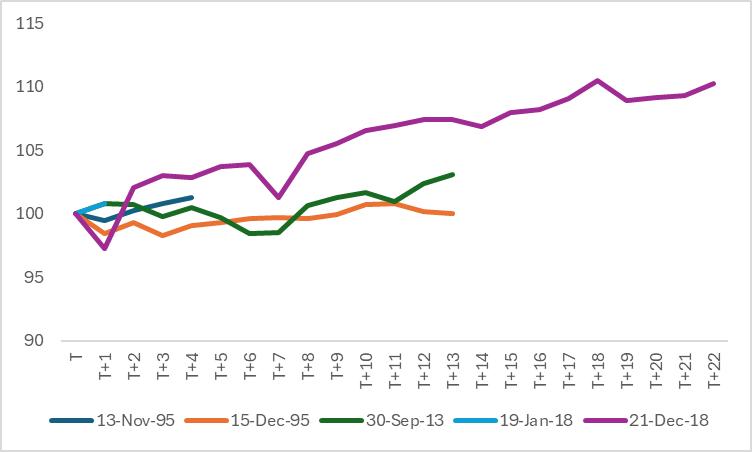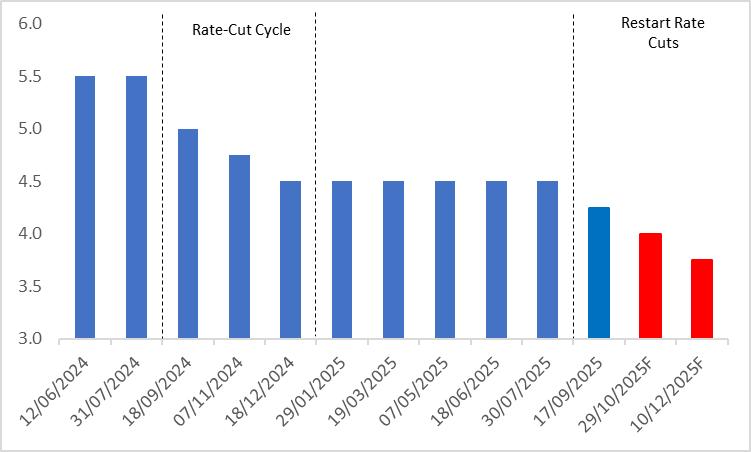U.S. Government Shutdown Commentary: Is a Stock Market Crash Imminent? Will Gold Prices Continue to Surge?
1. Introduction
TradingKey - On 1 October 2025, the U.S. federal government officially entered a shutdown, impacting various asset classes. This article analyses two key markets most affected—U.S. equities and gold—to help investors identify potential opportunities. Our research conclusion: despite the government shutdown, both U.S. stocks and gold are expected to continue rising in the short term. In other words, while the shutdown may seem like bad economic news, it could paradoxically be positive for markets.
2. Impact of the Shutdown on U.S. Equities
Historically, out of numerous U.S. government shutdowns, only five have significantly disrupted operations for more than one business day, and during each of these, U.S. stock markets recorded gains (Figures 2.1 and 2.2). This suggests that the direct negative impact of a government shutdown on equities is relatively limited. The primary driver of market performance is investors’ anticipation of looser monetary policy from the Federal Reserve, spurred by concerns over economic slowdown. This expectation of monetary easing tends to outweigh the effects of economic uncertainty, ultimately driving positive returns in U.S. stocks.
Given the current low probability of a U.S. recession, the Federal Reserve’s recent rate cuts are characteristic of preventive monetary easing. Historical data and theoretical analysis confirm that during such preventive rate-cut cycles, U.S. stock markets typically experience upward momentum. Consequently, in the absence of a recession, the negative economic impact of a government shutdown is likely to be overshadowed by supportive monetary policy, turning economic bad news into positive momentum for equities. Based on our analysis of historical trends and the current economic environment, we believe U.S. stocks continue to have room for further gains.
While the broader U.S. stock market shows bullish potential, this does not imply that individual sectors or stocks are risk-free. For instance, the U.S. government shutdown significantly impacts the defence and aviation industries. Major defence contractors, such as Lockheed Martin, Northrop Grumman, and Raytheon, may encounter delays in contract approvals and payments, disrupting their revenue streams and project timelines. Similarly, airlines like Delta, United, and Southwest face operational challenges due to unpaid or absent employees at federal agencies like the Transportation Security Administration (TSA) and the Federal Aviation Administration (FAA), resulting in flight delays, cancellations, and a diminished passenger experience.
Figure 2.1: U.S. Stock Market Returns During Government Shutdown Periods Lasting More Than One Day in U.S. History

Source: Refinitiv, TradingKey
Figure 2.2: Performance of U.S. Stocks During the U.S. Government Shutdown

Note: The S&P 500 rebased = 100 on the shutdown day
Source: Refinitiv, TradingKey
3. Impact on Gold
The U.S. government shutdown has not only driven gold prices to record highs but also fuelled a sixth consecutive week of gains. The shutdown delays the release of critical economic indicators, such as non-farm payroll data, which the Federal Reserve relies on to assess economic conditions and shape monetary policy. This data vacuum complicates the Fed’s decision-making process, enhancing gold’s appeal as a safe-haven asset. Furthermore, we believe that the longer the shutdown persists, the greater the potential for gold price increases. Should the shutdown extend for multiple days or even weeks, gold prices could continue to surge significantly.
4. Origins and Macroeconomic Impact of the Shutdown
On 1 October 2025, the U.S. federal government officially entered a shutdown. The core conflict stems from a partisan divide: Republicans generally advocate maintaining current government funding levels until Thanksgiving, while Democrats push to reverse Medicaid cuts and extend Obamacare subsidies, resulting in a deadlock. Previously, Republican and Democratic congressional leaders met at the White House to negotiate, but internal divisions within the Republican Party, coupled with pressure from the Democratic left, prevented an agreement before the 1 October midnight deadline, triggering the shutdown.
Although the current U.S. government shutdown has led to furloughs for hundreds of thousands of federal employees, this will not directly impact key labour market indicators such as unemployment rates or non-farm payroll data. However, reduced income for these workers is likely to curb consumer spending to some extent, thereby slowing U.S. economic growth. With inflation currently under control, a weakening economic outlook will likely prompt the Federal Reserve to maintain its current rate-cutting trajectory, with two additional 25-basis-point cuts expected by year-end (Figure 4). If the shutdown persists for an extended period or has a deeper impact, the Fed may accelerate its rate cuts, potentially driving further gains in both U.S. equities and gold prices.
Figure 4: Fed Policy Rate (%)

Source: Refinitiv, TradingKey
5. Conclusion
Our analysis concludes that while the U.S. government shutdown is negative for the economy, it presents a positive outlook for financial markets. The shutdown itself has a limited direct impact on U.S. equities, with the Federal Reserve’s rate cuts serving as a stronger catalyst for stock market gains. Concurrently, the uncertainty caused by the shutdown enhances gold’s safe-haven appeal, supporting further price increases. Overall, we remain optimistic about the short-term performance of both U.S. stocks and gold amid the ongoing government shutdown.



